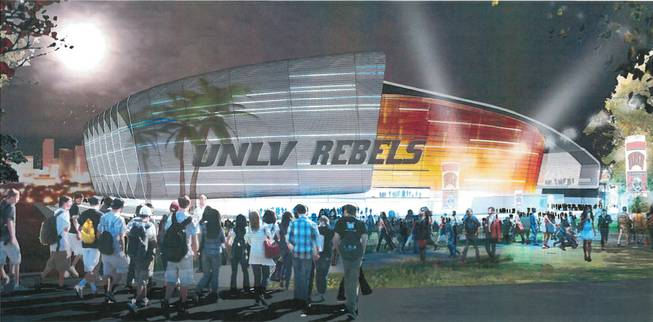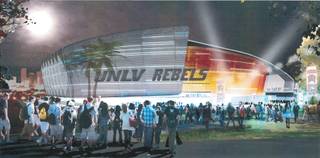
Courtesy
Complete coverage of the proposed UNLV Now stadium plan and the other arena and stadium proposals in town.
Published Friday, Nov. 30, 2012 | 11:24 a.m.
Updated Friday, Nov. 30, 2012 | 8:45 p.m.
Nevada's higher education leaders unanimously approved UNLV's master plan, which includes the stadium project, on Friday.
With the Nevada System of Higher Education's approval of a campus master plan, UNLV and its private partner Majestic Realty Co. can now move forward with the details of a proposal to build a covered, 60,000-seat stadium on its Maryland Parkway campus.
Officials hope the "UNLV Now" stadium project would be a "game-changer" for the university, and a major regional attraction that could bring the likes of an NFL exhibition game, Comic-Con and the Electric Daisy Carnival to campus.
A stadium at UNLV would attract more quality students and faculty to campus and transform campus life from less of a commuter atmosphere to a more residential one, officials said. There is also the potential for a lot of money to be made — on campus and regionally.
The stadium could pump $393.2 million to the Las Vegas economy annually if constructed, according to an economic impact report released Friday.
The study was written by Mark Rosentraub, a project consultant from the University of Michigan's Center for Sport Management, and was funded by UNLV and Majestic Realty.
The stadium is estimated to draw at least 15 new major events and about 472,500 visitors each year, according to the report. Anticipated events include the following:
• Sporting events such as a Mountain West or Pacific-12 football championship game, the X-Games, Wrestlemania, UFC International Fight Week, a Major League Soccer All-Star game and a NCAA Final Four basketball game.
• Music concerts and festivals such as the Electronic Daisy Carnival, the Country Music Festival and a Rock Music Festival.
• Other major events such as the Republican or Democratic National Convention, Comic-Con and corporate events.
The stadium could attract a Major League Soccer team to Las Vegas, which lacks a major sports team, said Majestic's Craig Cavileer, president of the Silverton resort. Any major events held currently at the Thomas & Mack Center — such as the National Finals Rodeo — could be hosted at the new stadium as well.
The report estimates that each of these 15 events would attract about 31,500 people.
If each person spends an average of $100 per ticket and $40 in food/souvenir purchases, UNLV stands to raise $66.1 million in on-campus revenue annually.
The nearby Las Vegas Strip, the local construction industry and Nevada's coffers also stand to benefit.
The stadium would support local resort and retail venues, which could rake in more than $327 million in new revenue each year.
The report adds that stadium construction would generate more than $197 million in wages and nearly $30 million in additional tax revenue for state and local governments.
If UNLV is able to attract 30 major events to a new UNLV stadium, the total economic impact for Las Vegas could approach $790 million.
Although final cost estimates and financing details have yet to be released, the stadium’s cost is estimated at $800 million. UNLV officials plan to have final budget figures and deal hammered out by late February.
UNLV and the developers earlier had said about one-third, or about $270 million, of the cost would come from long-term naming rights and numerous forms of advertising.
Another third would come from revenue generated at the site.
The last third would come in the form of a sort of tax-incremental financing plan, which would help developers obtain long-term financing. UNLV is expected to ask the Legislature for a special tax district to help support the stadium's construction.
Last legislative session, UNLV's bid for a tax-district failed in the 11th hour. It fail in part, officials said, because it was bundled with two other stadium projects in the valley.
This time, UNLV officials are more hopeful as the other two projects — in Henderson and in Las Vegas — have hit hiccups.
"We're more optimistic, but we have a lot of work to do," said Don Snyder, UNLV's hotel college dean and lead project manager. (Snyder was involved in building the Fremont Street Experience and the new Smith Center, both of which were public-private projects similar to the UNLV Now stadium proposal.)
The mega-events center is envisioned at the site of the current UNLV baseball facility, north of Harmon Avenue and east of Swenson Street. The baseball field would be moved south, between Harmon and Tropicana avenues, and expanded to include a soccer field and baseball diamonds.
A new "student village" would be sandwiched between the athletic fields and the stadium area. This village, consist of retail shops and expanded student dorms and apartments, will be key to UNLV's transition from a commuter school to a residential campus.
Regents asked questions about the stadium proposal and master plan — issues such as financing and safety — but remained supportive of the project.
Regent Jack Schofield, 89, was especially enthusiastic about the proposal. The former UNLV student saw the campus open in 1957 and has watched it grow into Southern Nevada's premier research institution ever since.
"This is an investment in my opinion. We're investing, not spending," Schofield said. "We have an opportunity here to succeed and I hope we don't flub it."


Join the Discussion:
Check this out for a full explanation of our conversion to the LiveFyre commenting system and instructions on how to sign up for an account.
Full comments policy